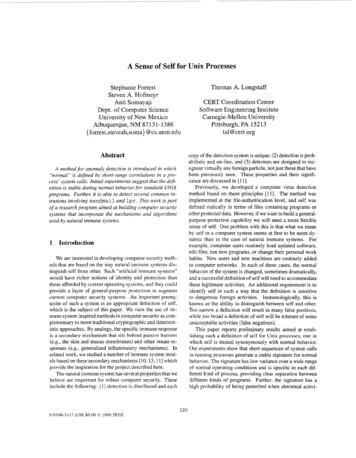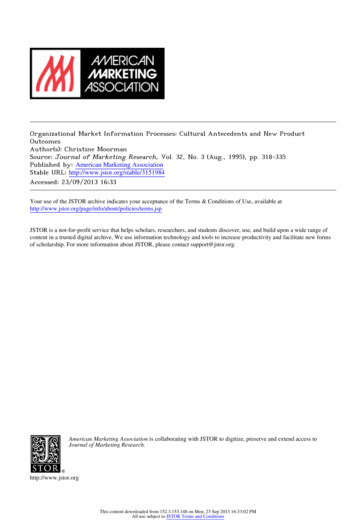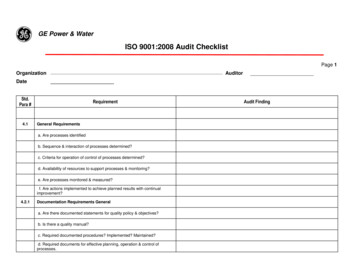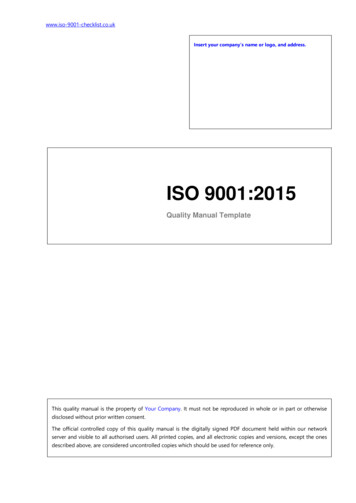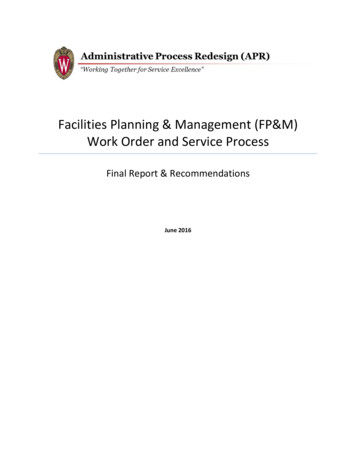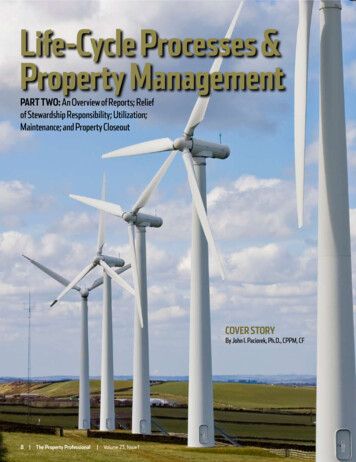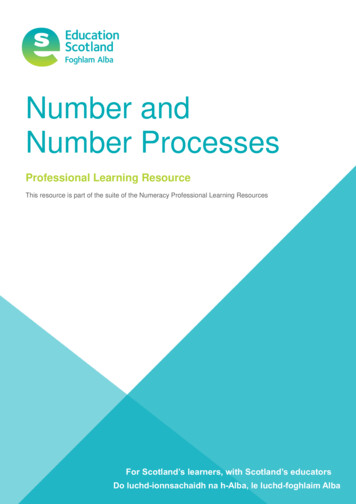
Transcription
Number andNumber ProcessesProfessional Learning ResourceThis resource is part of the suite of the Numeracy Professional Learning ResourcesDo luchd-ionnsachaidh na h-Alba, le luchd-foghlaim Alba
ContentsPage03 Introduction04 Early Level20 First Level29 Second Level39 Third Level44 Fourth Level2 Number and Number Processes – Professional Learning Resource
IntroductionThis professional learning resource has been created to enable practitioners to reflect on theirown knowledge and understanding, highlight areas which children find challenging and outlineeffective approaches to support future learning and teaching in Number and NumberProcesses.Numbers are all around us and they are used in many different ways. Developing anunderstanding of numbers and their role in the description of quantities is fundamental toforming the connections needed to describe a group of objects. To be confident andcomfortable with numbers, it is necessary to understand how the number system works andhow numbers relate to each other.Developing an understanding that we have both words and symbols for all the numbers weuse is important in developing an ability to count accurately and understand one to onecorrespondence. Learners need to visualise, hold and manipulate numbers as this helps todemonstrate an understanding of the number system and how it works.Being able to apply numeracy skills across a variety of real life contexts leads to beingnumerate and being able to function responsibly in everyday life, contribute effectively tosociety and increase our opportunities within the world of work.National Numeracy and Mathematics Progression Framework1Number and Number Processes1Further guidance on using the National Numeracy and Mathematics Progression Frameworkcan be found by clicking here.3 Number and Number Processes – Professional Learning Resource
Early LevelThe table below includes the experiences and outcomes related to ‘Number and NumberProcesses’ at early level. The experiences and outcomes should be used in the planning oflearning, teaching and assessment. It is important to note that the benchmarks are designed tosupport teacher professional judgement in progress towards and achievement of a level. There area range of different experiences that learners need to be exposed to before these can beachieved.Experiencesand OutcomesBenchmarksI have explorednumbers,understanding thatthey representquantities, and Ican use them tocount, createsequences anddescribe order.MNU 0-02a Explains that zero means there is none of a particular quantity and is represented by thenumeral 0. Recalls the number sequence forwards within the range 0 - 30, from any given number. Recalls the number sequence backwards from 20. Identifies and recognises numbers from 0 to 20. Orders all numbers forwards and backwards within the range 0 - 20. Identifies the number before, the number after and missing numbers in a sequence within 20. Uses one-to-one correspondence to count a given number of objects to 20. Identifies ‘how many?’ in regular dot patterns, for example, arrays, five frames, ten frames,dice and irregular dot patterns, without having to count (subitising). Groups items recognising that the appearance of the group has no effect on the overall total(conservation of number). Uses ordinal numbers in real life contexts, for example, ‘I am third in the line’. Uses the language of before, after and in-between. Counts on and back in ones to add and subtract. Doubles numbers to a total of 10 mentally. When counting objects, understands that the number name of the last object counted is thename given to the total number of objects in the group.I use practicalmaterials and can‘count on and back’to help meunderstand additionand subtraction,recording my ideasand solutions indifferent ways.MNU 0-03aEstablishing Strong Foundations for LearningCareful consideration should be given to the spaces, interactions and experiences we provide,ensuring that opportunities for learners to develop the concept of number permeates across all.SpacesRich, carefully considered learning spaces both outdoor and indoor can offer learners practicalopportunities to develop the concept of number. The choice of experiences on offer should reflectan environment of open-ended possibilities in which children can feel intrinsically motivated toexplore and investigate numbers through play. Selecting appropriate and engaging resources canenhance interactions; leading to creativity, curiosity and deeper learning.Open-ended materials offer the potential for creative explorations through child-initiated and adultinitiated learning experiences. Spaces should be planned to provide a balance of opportunities forlearners to play, explore, investigate and question. Practitioners should ensure that planning forlearning starts with the child and is carefully balanced to be both responsive and intentional indesign. Opportunities should enable learners to make sense of numbers and number processes inthe world around them, whilst also ensuring learners’ needs are being met through theirengagement with the experiences and outcomes presented within early level.4 Number and Number Processes – Professional Learning Resource
There are many different ways of permeating number across the learning spaces. Some examplesof how to do this are provided below.Signs which show numbers displayed indifferent ways.Typed and handwritten digits andnumerals prominently displayed.3threeDisplay numerals from the widerenvironment such as door signs, busnumbers and road signs.Provide containers of different sizes andcapacities.Provide access to real life objects containingnumbers. Items could include calendars,diaries, calculators, tape measures, pricetags, recipe books, shopping lists, measuringscales, telephones, coins and many more.Provide a variety of types of containers suchas egg boxes, tins, baskets, cake trays,muffin tins.Provide a variety of loose parts such asbuttons, corks, pasta, shells, pegs and beads.Provide sets of items such as cups,bowls and plates.Provide collections of toy cars, people andanimals.Provide a variety of natural items such asleaves, stones, twigs, pine cones andconkers. These can also be collected by thelearners themselves.Provide a range of mark makingmaterials such as chalk, brushes,markers, clip boards and paint.Provide richly illustrated story bookswith representations of number.Provide malleable material such as dough,modelling clay and associated tools.5 Number and Number Processes – Professional Learning Resource
Interactions – One of the roles of the PractitionerOne of the roles of the practitioner is to determine what the child could learn through their owninterests using high quality interactions. Practitioners should support learners to extend theirlearning of number and number processes through encouragement of creativity and curiosity.Careful observation is an important assessment tool, as is knowing when to stand back andgive learners time to investigate by themselves. It is important to notice when learners are morereceptive to further support from the practitioner and address any misconceptions that maycause challenges at later stages.Language can be used as a powerful vehicle for the teaching and understanding of number andnumber processes. When interacting with learners, practitioners can model the use of relevantvocabulary in meaningful contexts. This allows learners to make links between the spoken wordand the associated learning. Using language in the correct context regularly will supportlearners’ understanding.I wonder how manypaintbrushes we willneed for everyone toget one each?I wonder how manyblocks we could addin before the towerfalls down?I wonder how manyclaps/taps/clicks youcan hear?I notice youhave four piecesof fruit today.I noticed youwere sharingyour beads.I wonder whohas moreshells, you orme?Can you findme onemore/less?I wonder how wecould work out howmany cars there are?I wonder why thatnumber is on that signon the path?Practitioners should also embed numbers in everyday conversations.Oh, look – thereare threeworms on theground.It is two o’clock.6 Number and Number Processes – Professional Learning ResourceWe have fivechildrenlistening to thisstory today.
Experiences and RoutinesLearners need to be immersed in number. This includes numerals, associated number namesand corresponding quantities for each number. Providing strong foundations and developingnumber sense at the early stages of learning are important as these skills help support youngchildren to positively engage in and investigate a range of basic mathematical concepts.Experiences of everyday activities are important, both indoor and outdoor. Some examples ofthese are noted below, there are many more.baking/cookingcollecting items of interestphysical activity (star jumps, etc)walks round the local areamark makingtraffic surveysconstructiontreasure huntswater/sand playsnack/meal timesexperienceswhich cansupport thedevelopmentof numbersongsrhymesmoving between areasstoriesgetting ready to go outrole playgamesWithin these experiences the following number skills can be developed.2subitisingusing ordinal numbersrecognising differentways a number can berepresented (see page 5)identifying the number before andafteridentifying the missing numbersin a range of sequencescounting:1:1 correspondence, stable order,cardinality, abstraction, conservationof number, order of relevance²2understandingconcept of zeronumeralrecognition/identificationforward andbackward numberword sequencesCounting Principals: Gelman and Gallistel (1978): Gelman, R. & Gallistel, C. (1978) The Child's Understanding of Number. Cambridge,MA. Harvard University Press.7 Number and Number Processes – Professional Learning Resource
Stories, Rhymes and SongsIn ELC and early primary we know that stories, rhymes and songs connect young children tomany aspects of learning and development through diverse, meaningful and rich contexts.Their words and rhythms provide a fun and creative way of exploring numbers and numberprocesses alongside developing associated vocabulary. Incorporating these into practice alsoenhances movement, coordination, positional language, as well as supporting early numbersense. Our brains have become hardwired to respond to stories and learners can use stories,songs and rhymes to make sense of the world. Their repetition reinforces learning throughencouraging a young child’s natural schematic behaviour.Through a range of traditional and contemporary songs, stories and rhymes we can engagelearners’ interests and curiosity and help them understand abstract concepts. There are manystories, rhymes and songs that address mathematical concepts and they can be adapted orused in provocations to illustrate a concept or pose an investigation for learners to problemsolve.ELC and early primary settings already provide a rich array of songs, stories and rhymes foryoung children. Further inspiration, if needed, can be found on the Scottish Book Trust’sBookbug pages.We already know that actions, puppets and objects are effective in acting out what is happeningin the stories, rhymes and songs – but consider how these also provide young children withvisual and physical reinforcement of concepts. Encouraging young children to be creative withstories, songs and rhymes can provide a powerful observational tool in assessing theirunderstanding of concepts.8 Number and Number Processes – Professional Learning Resource
Number Word Sequences and NumeralsFive and ten frames are excellent resources for developing number sense within the context often. They can be created using physical objects and materials that the learners are interested inand familiar with.How many buttonshave you collected?What do younotice?I wonder howmany stonesthere are?I wonder if there isa different way wecould show thisnumber?I think thatthere are fiveleaves. Howcan we check?Learners could be asked to find numeral cards that match thenumbers.It is important to develop numeral recognition. Adults should model numeral formation dailyand display a range of written and typed numerals. Number lines can provide a visual supportin developing an understanding of number.Can you find thenumber five?Learners could create giant number lines that they can stand on.Cover a number on thenumber line with a beanbag.‘I wonder which number hasbeen covered? ‘I am standing on the number fourand you are standing on thenumber six. Which number is inbetween us?9 Number and Number Processes – Professional Learning Resource
Counting CollectionsThe important skills and understanding that make up counting can be developed through manyopportunities to count; this could be developed through using counting collections. It is alwaysimportant to start from where the child is at in their learning and development. This isdetermined through close observation.Learners should be provided with a variety of interesting materials to count; the collection sizeshould vary according to learner need and/or specific learning intention. The collection couldinvolve counting counters, straws, stones, toy cars, keys; essentially any objects available or ofinterest to the learners.Leaners could either work alone or together to determine the total; negotiating the way they willcount their collection and then recording how they counted. Learners can be encouraged tocount and represent in ways that make sense to them. As learners count, they might moveobjects in and out of containers, set them out in a line, sort into groups by colour or size,etc. Through practise, modelling and scaffolding, learners develop more efficient and accuratemethods. Constant observation of how the child interacts with the materials is crucial todetermine how their thinking is developing and what can be provided to reinforce or furtherdevelop learning.Learners are working to coordinate three aspects of number during a counting collection activity.For example, to really understand what 6 means, it is helpful if learners are provided withopportunities to connect the name (“six”), the quantity (6 items), and the written numeral (6).It is important to develop understanding of the fact that anything can be counted. Opportunitiesto count non-physical objects such as claps, beats of a drum, environmental sounds or words ina sentence are a good way to explore this concept. Experimenting with sound patterns atdifferent speeds can develop this understanding further, for example, 5 slow claps comparedwith 2 quick claps and 3 slow claps.Lots of exposure to hands on activities using numerals will help consolidate learning. Someexamples of these are listed below. Using sensory art to create a number using sand, paint, foam, etc.Going on a ’number hunt’ matching number names and objects of the same value.Creating a numbered car park with numbered cars, and suggesting children to place, forexample, car 8 in parking space number eight at tidy time.Having numbers and number names on containers. Children select a container and putobjects of their choice in the container to match the number.Using numerals to label spaces where resources are kept.10 Number and Number Processes – Professional Learning Resource
Points to consider: Learners need plentiful opportunities to develop the skill of cardinality; being able torecognise the final number of count as the cardinal value.Some learners may assume that when objects are spread out that there are more ofthem (conservation of number). In the picture below, the blocks are spread out differentlybut there are still five in each row.When counting, learners may use number names in an incorrect order, or may countobjects more than once.Some learners may appear to be counting confidently but that may be because they arejust be mimicking the rhythm of the counting pattern.Some learners may not understand the relationship between numbers and theirassociated quantities.Learners may mix up certain numerals, for example, 6 and 9 or 12 and 20.The concept of zero can be challenging for some learners. Songs, games and activitiescan be used to reinforce that zero means ‘nothing’.Children will need lots of opportunity to count combinations of objects and to recognisetotals without counting (subitise). Using familiar dot patterns such as dominos and dicehelps children to visualise what a number looks like without having to count from one.Addition and Subtraction - Effective learning and teaching approachesWhen introducing addition and subtraction it is important that the experiences provided arerelatable to the lives of learners. When children are confident counting a group of items andhave a sound understanding that the last number they count is the total they should then begiven lots of opportunity to count sets of objects together. Lots of practical investigations usingconcrete material are essential before formal calculations are introduced.It is important that addition and subtraction are taught together as this will support a deeperunderstanding of the relationship between them.11 Number and Number Processes – Professional Learning Resource
Toys, food and other everyday objects can be used to develop understanding of addition andsubtraction.I wonder what wouldhappen if I addedtwo more cars?You have three cars and Ihave two cars, how can wefind out how many we havealtogether?I wonder what wouldhappen if I tookaway two cars?This could then progress to screening one of the sets to develop the learners’ skills in countingon from different numbers. In the example below the first set of cars have been covered with asheet of paper.There are three carsunder the paper. I’veadded two. How manydo we have now?I had some cars. I’ve taken threeaway, now there are two. I wonderhow many cars I started with?12 Number and Number Processes – Professional Learning Resource
Backwards counting is a fundamental building block for learners enabling them to build skills incounting back and subtracting accurately.Previous suggested activities in relation to number lines can be extended to develop theconcept of addition and subtraction.I am on the number five and youare on the number two. Howmany jumps will it take you toget to me?I wonder what numberyou would be on if youjumped backwards onespace, two spaces, etc.?I wonder what numberyou would be on if youjumped forward onespace, two spaces, etc.?Learners can use dice and dominoes to develop their understanding of addition andsubtraction.I see afour anda oneI see 3 2I see two plustwo plus oneLet’s roll anotherdie. I wonder howmany dots do wehave now.13 Number and Number Processes – Professional Learning ResourceWhat do you see? How doyou see it?I wonder if you can show methe total number of dots in adifferent way?
Finger PatternsLearners learn to make sense of the numbers around them in lots of different ways. This canoften include using their fingers to help them count. This is a very important stage in learners’number development and should be actively encouraged and supported.Children will initially count their fingers in sequential order 1, 2, 3 before being able to recognisethe different finger patterns. It can take some learners time to realise that they have 5 fingers onboth hands making 10 altogether. It is important to spend time teaching finger patterns to helplearners develop this understanding.I have made four,can you do thistoo?Watch me as Icount my fingers.Can you do thistoo?I am going to usemy fingers tomake doubles.4 4 8I wonder whathappens if I addone morefinger?I have five fingers on thishand and two more onthis hand. I wonder howmany altogether?When asked to show four fingers, learners generally start with counting one at a time; one,two, three, four before proceeding to show four. With practice, this can be progressed furtheras learners show four fingers automatically, without the need to count individually. To providefurther challenge, learners can be asked, “I wonder if you can show me four using two hands?”When children can confidently make finger patterns without counting they can be asked to hidetheir fingers either raising them above their eye line or behind their back to make tasks morechallenging.Put your hands behindyour back. Can youput up six fingers?How many fingers aredown?Withoutlooking atyour fingerscan you showme seven?Put both your handsabove your head. Canyou show me eightfingers? Can you showme this in a differentway?Some learners may need additional support when using finger patterns due to their motor skillsand finger dexterity. It is important to consider how we will adapt activities to ensure all learnerscan take part. It may be that the learner uses the adult’s fingers or they could use electronichands on a smart board/tablet. Another way to adapt the activity is to use waterproof glovesfilled with sand.14 Number and Number Processes – Professional Learning Resource
Five and ten frames can also be used to investigate addition and subtraction.How manyblue dotsare there?I wonder howmany dotsthere arealtogether?How manyorange dotsare there?I wonder howmany more dotswe would need tofill the grid?How many twistybits of pasta arethere? How manyshell shape pieces?Could we add thedifferent pieces ofpasta together?The use of concrete materials can then be extended to develop written calculations to supportunderstanding of the part-part-whole approach; allowing learners to see the relationshipbetween a number and its component parts. For example, ask learners to roll two dice andrecord the numbers they see. “Can you make a number sentence using the two numbers youhave rolled”? “I wonder how many dots we have altogether?”3 2 52 3 55–3 25–2 388 5 135 8 13513 – 8 513 – 5 813This can lead to learners being able to develop an understanding of the relationship betweenthe whole number and the component parts and can support the understanding of theconnection between addition and subtraction.15 Number and Number Processes – Professional Learning Resource
What is the missing number? How do you know? Can you prove it?55 ? 8? 5 88?Using ten frames is another useful concrete material which can help facilitate this thinking.These can be physical ten frames that learners can place items on or into and can progress topictorial representations.7 5 125 7 1212 – 7 512 – 5 7Learners are encouraged to fill one ten frame first by using three of the blue counters. Thishelps pupils ‘visualise’ the answer as one ten and a two; 12. Written responses are encouraged,so that learners can link to the abstract method.Counting on and back using a number line allows learners to visualise their thinking.Example (1)I have five pizzas for the birthday party and I order one more. How many pizzas do I have intotal?Example (2)I have eight eggs, but I use one for my breakfast. How many eggs do I have left?16 Number and Number Processes – Professional Learning Resource
Early addition facts lead on to doubles and multiplication. It is important to progress to showingthis in different ways.For example: What do you see? “ I see 2 red and 2 blue”“ I see 2 and 2 more”“ I can represent this as 2 2”“ I see 2 lots of 2”“ I see double 2”“ I can represent this as 2 x 2”“ I see 4”For example: “What do you see on row 1?”“What do you see on row 2?”How many more white beads are needed to make 10 on the top row?5 ? 810 – 2 ?17 Number and Number Processes – Professional Learning Resource
Partitioning QuantitiesAt early level it is important that learners are provided with opportunities to further develop theirunderstanding of doubles and halves. Opportunities for partitioning quantities into two or moreparts are also essential skills that should be developed at this stage. Formal teaching ofmultiplication and division is introduced in first level, however, these skills form the foundationsof understanding of multiplication and division.This should be explored using real life objects and materials that can be found both indoor andoutdoor. Examples of objects and materials which could be used can be found on page five ofthis document.There are three of us here todayand we have nine sticks. How canwe make sure we all have the samenumber of sticks?We have six leaves. If we sharethem equally between us Iwonder how many leaves wewill have each?I wonder how we couldmake sure that youand your friend bothhave an equal amountof toy cars?Grouping and SharingThrough grouping and sharing small quantities, learners begin to lay the foundations formultiplication and division, doubling numbers and quantities. They can make connectionsbetween arrays and number patterns.In equal sharing learners would start with the number of groups and share the objects equallybetween each group.I wonder what the bestway to share thesestrawberries between youand your friend is?18 Number and Number Processes – Professional Learning Resource
In grouping, learners know the number of objects each group should receive. They also knowwhat the total number of objects to begin with is.We have ten leaves. Iwonder if we can makegroups of two withthem?There are nine of us here today.Can we get into groups of three?Points to consider: The link between addition and subtraction should be continually reinforced to ensure thatlearners develop confidence and fluency in both processes.Saying “we can’t do 3 - 5” can cause misconceptions when learners start to work innegative numbers.Some learners may still count in ones to confirm ‘how many’ there are in a collection ofequal groups.Doubling and halving should be taught together to reinforce their connection.Reflective questions: Do the available experiences and spaces (both outdoor and indoor) provide openended possibilities which motivate learners to explore and investigate number andnumber processes?Do we take time to observe the actions, emotions and words of the learners andrespond sensitively to them?19 Number and Number Processes – Professional Learning Resource
First LevelThe table below includes the experiences and outcomes related to ‘Number and NumberProcesses’ at first level. The experiences and outcomes should be used in the planning oflearning, teaching and assessment. It is important to note that the benchmarks are designed tosupport teacher professional judgement in progress towards and achievement of a level. There area range of different experiences that learners need to be exposed to before these can beachieved.Experiences andOutcomesBenchmarksI have investigated howwhole numbers areconstructed, canunderstand theimportance of zerowithin the system andcan use my knowledgeto explain the linkbetween a digit, itsplace and its value.MNU 1-02a Reads, writes, orders and recites whole numbers to 1000, starting from any number in thesequence. Demonstrates understanding of zero as a placeholder in whole numbers to 1000. Uses correct mathematical vocabulary when discussing the four operations including,subtract, add, sum of, total, multiply, product, divide and shared equally. Identifies the valueof each digit in a whole number with three digits, for example, 867 800 60 7. Counts forwards and backwards in 2s, 5s, 10s and 100s. Demonstrates understanding of the commutative law, for example, 6 3 3 6 or 2 4 4 2. Applies strategies to determine multiplication facts, for example, repeated addition, grouping,arrays and multiplication facts. Solves addition and subtraction problems with three digit whole numbers. Adds and subtracts multiples of 10 or 100 to or from any whole number to 1000. Applies strategies to determine division facts, for example, repeated subtraction, equalgroups, sharing equally, arrays and multiplication facts. Uses multiplication and division facts to solve problems within the number range 0 to 1000. Multiplies and divides whole numbers by 10 and 100 (whole number answers only). Applies knowledge of inverse operations (addition and subtraction; multiplication anddivision). Solves two step problems.I can use addition,subtraction,multiplication anddivision when solvingproblems, making bestuse of the mentalstrategies and writtenskills I have developed.MNU 1-03aAddition and SubtractionIt is important to establish how learners reach conclusions when faced with a simpleaddition/subtraction calculation. Some learners may: use counters or other concrete materialscount from oneapply the counting on strategyadopt a more effective strategy such as the jump strategyuse doubles/near doubles to calculate their answer.It is important that concrete and pictorial representations are explored, investigated anddiscussed before moving onto more abstract methods. Learners benefit from opportunities totalk about the strategy they have chosen and, through observations and discussions,practitioners should be able to identify gaps in learners’ knowledge. This can inform planning sothat learners can develop more efficient strategies. These opportunities should also allow thediscussion of associated vocabulary.It is important to plan for the mental skill of estimation alongside activities so that learners cancheck the reasonableness of their answers.20 Number and Number Processes – Professional Learning Resource
Effective learning and teaching approaches (concrete and visual representations)A wide variety of concrete materials are available to support understanding of addition,subtraction and place value.Using ten frames to find 27 28Fill the third frame using countersfrom the last frame to make anotherset of ten, resulting in five sets of tenand five ones.Using partitioning for 27 28:27 28 20 20 407 8 7 3 540 10 5 55Using base 10 materials to find 26 13Group the tens, and then the onestogether resulting in three sets of tenand nine ones.Representing 26 13 on a number line: 1026 33639Using conceptual
Recalls the number sequence backwards from 20. Identifies and recognises numbers from 0 to 20. Orders all numbers forwards and backwards within the range 0 - 20. Identifies the number before, the number after and missing numbers in a sequence within 20. Uses one-to-one correspondence to count a given number of objects to 20.

